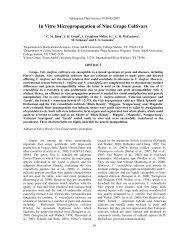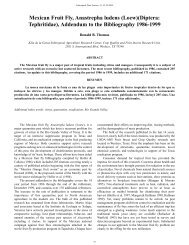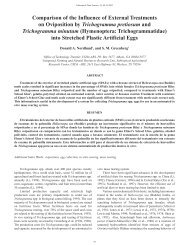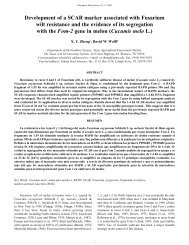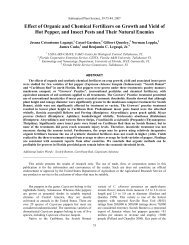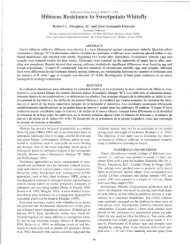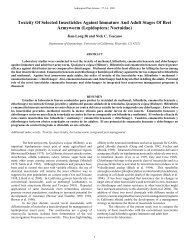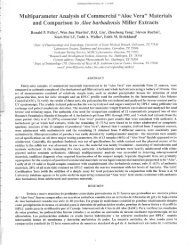Subtropical Plant Sci. J. 58:29-34. - Subtropical Plant Science Society
Subtropical Plant Sci. J. 58:29-34. - Subtropical Plant Science Society
Subtropical Plant Sci. J. 58:29-34. - Subtropical Plant Science Society
You also want an ePaper? Increase the reach of your titles
YUMPU automatically turns print PDFs into web optimized ePapers that Google loves.
<strong>Subtropical</strong> <strong>Plant</strong> <strong>Sci</strong>ence <strong>58</strong>:<strong>29</strong>-34 (2006).<br />
11 L pot containing soil-less media, Sunshine Mix #4 (Sun Gro<br />
Horticulture Inc., Bellevue, Wash.). Peters 20N-8.7P-16.6K water<br />
soluble fertilizer (Scotts, Marysville, Ohio) was applied weekly.<br />
Pesticides were applied as needed to control diseases. Approximate<br />
day/night greenhouse temperatures were 25±3/22±2 EC. Day<br />
lengths ranged from 12 to 10 h light in this experiment.<br />
For confirmation of the marker-QTL associations, 64 F 2<br />
plants from the cross of ‘Deltex’ x TGR1551 were planted on black<br />
plastic mulch with drip irrigation on sandy clay loam soil at<br />
Weslaco, Texas on 10 Mar. 2002. The high sugar ‘Deltex’ parent<br />
is a commercial ananas cultivar (Nunhems, Parma, Idaho). Single<br />
bed length and width were 31.7 m and 1.0 m, respectively, with<br />
30.5 cm spacing between plants and 1.0 m between beds. A<br />
fertilizer containing 5N-11.3P-27.4K (Wilbur Ellis, Edinburg,<br />
Texas) was applied weekly. Irrigation was supplied as needed.<br />
Approximate day/night field temperatures were 30±3/23±3 EC. Day<br />
lengths ranged from 12 to 14 h light.<br />
Data Collection. Data for TSS were obtained from the<br />
two parental pairs as well as the 105 and 64 F 2 plants using a<br />
temperature corrected refractometer with digital readout (Reichert<br />
<strong>Sci</strong>entific Instruments, Buffalo, N.Y.). Stamen presence and<br />
absence in female flowers were checked thrice on all F 2 plants and<br />
parents at different times during flowering.<br />
RAPD. Fully expanded leaves of the 105 and 64 F 2 plants<br />
along with their parental pairs were collected at 21 days after<br />
planting. Total genomic DNA was extracted from the leaf tissue<br />
using the method of Skroch and Nienhuis (1995). A total of 500<br />
random 10-mer primers (Operon Technologies, Alameda, Calif.)<br />
were used for the RAPD analysis (Williams et al., 1990).<br />
Polymerase chain reactions (PCR) were performed on 96-well<br />
plates in a MJ Research thermalcycler (model PTC-0100; MJ<br />
Research, Waltham, Mass.). Protocols for PCR and the<br />
composition of the final volume of reactants were the same as those<br />
described by Skroch and Nienhuis (1995). A 100-base pair (bp)<br />
DNA ladder (Life Technologies, Grand Island, N.Y.) was used to<br />
estimate the length of RAPD markers. The name of each RAPD<br />
marker is derived from an “O” prefix for Operon primers, the<br />
letters identifying the Operon kit, Operon primer number, and the<br />
approximate length (bp) of the marker (Park et al., 2004a).<br />
Bulked Segregant Analysis. Two low and high bulks were<br />
prepared from equal volumes of standardized DNA (10 ng . μL -1 )<br />
from eight selected F 2 plants of the ‘TAM Dulce’ x TGR1551 cross<br />
with the highest and lowest TSS values, respectively. The 500<br />
primers were used to simultaneously screen between the low and<br />
high DNA bulks, and between the parents ‘TAM Dulce’ and<br />
TGR1551. Primers that generated marker polymorphisms between<br />
the low and high DNA bulks were tested in the F 2 population from<br />
the cross between ‘TAM Dulce’ and TGR1551 for identifying<br />
QTL. Four primers were tested in the F 2 population of the ‘Deltex’<br />
x TGR1551 cross for confirming the RAPD marker-QTL<br />
associations.<br />
Linkage Analysis. To detect segregation distortion of<br />
markers and andromonoecious, F 2 population marker data were<br />
tested for goodness-of-fit to a 3:1 ratio using the chi-square test.<br />
Due to the dominant nature of RAPD markers, the linkage analyses<br />
of two markers obtained from ‘TAM Dulce’ and four markers<br />
including a obtained from TGR1551 were separately performed on<br />
the data for 105 F 2 plants of the ‘TAM Dulce’ x TGR1551 cross<br />
using MAPMAKER version 3.0 (Lander et al., 1987). We also<br />
executed separately the linkage analyses of two markers from<br />
‘Deltex’ and two markers from TGR1551 on the data for 64 F 2<br />
plants of the ‘Deltex’ x TGR1551 cross.<br />
Detection of QTL. Simple linear regression, for each<br />
pairwise combination of quantitative traits and marker loci, was<br />
used to analyze the greenhouse and field data for detection and<br />
confirmation of QTL for TSS. Significant differences in trait<br />
associations were based on F-tests (P



